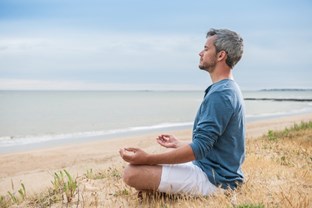You’ve probably heard the popular buzzword ‘mindfulness’ used in a variety of contexts – at work, at the doctor’s office, maybe even at the gym. But what is mindfulness exactly, and why is it such an omnipresent concept these days? Mark Waldren explains.
What is Mindfulness?
Mindfulness is an ancient form of meditation, but a little different from what you might think of as traditional meditation. Mindfulness is an awareness of your thoughts, feelings, body and environment on a moment-to-moment basis. It means that wherever you are and whatever activity you are engaged in you are training your mind to be in that exact moment and noticing all of the sensations you are experiencing instead of drifting off to another place. Aside from helping you find focus and balance in a chaotic world, there are a number of health benefits of practicing mindfulness.

A study published in the Journal of Occupational Health Psychology reported that weekly yoga practice and mindfulness resulted in significantly lower stress levels and reduced difficulties in sleeping.
Research from UC Santa Barbara found that college students who were trained in mindfulness performed better on the verbal reasoning section of the GRE and experienced improvements in their working memory. It has also been linked with positive brain changes that could even have preventive effects against mental illness.
Practicing Mindfulness
There are a number of ways that you can practice mindfulness – and most of them are much easier than you might think. It boils down to the simple process of noticing new sensations and your surroundings in order to keep yourself in the present.
The idea is to stay as engaged as possible with the task at hand.
Here are a few steps to keep in mind:
- Pay attention to your breathing.
- Notice all five of your senses.
- If your mind begins to wander, slowly bring it back to your present activity.
There are many activities that can help you with a daily practice of mindfulness.
Colouring In
Adult colouring books are a popular craze that can help with stress relief. They are books filled with pages of black and white sketches or designs that you then get to colour in with markers or coloured pencils. The designs are typically much more intricate and sophisticated than children’s books and the idea is that you stay completely absorbed in the task of colouring, staying within the lines, expressing creativity and maintaining total focus in order to reach a soothing state. The crux of the new craze of colouring books for adults, is the premise that the focus you give the task allows you to be present, relaxes the body and calms the mind.
Mindful Eating
These days food is often thought of as fuel, we simply consume it to give us energy for the day. This can be a healthy outlook towards food and eating however may not add to a mindful practice.
Mindful eating suggests that we eat with intention and attention. It involves an awareness of your body, your hunger level, the way you are experiencing the smell, taste and texture of the food you’re eating and a slow and thoughtful enjoyment of the act of eating. A number of studies have shown that subjects who participated in mindfulness workshops centered around mindful eating exhibited a decline in binge eating episodes as well as anxiety and depressive symptoms, external-based eating, chronic stress and lowered abdominal fat.
General Awareness
A more general way to think of mindfulness is simply bringing attention to the task you are involved with. For example, perhaps when you do the dishes you find yourself rushing through the task to get it done so you can relax. Often we rush through mundane tasks with so little thought that we can barely remember doing them. If you are looking to bring more mindfulness to your daily life, perhaps next time you’re washing the dishes, notice the way you’re body feels as you’re standing in the kitchen. How does the water feel on your hands? What does it look like as it slides down the glass? What do the soap suds look like? What do they smell like? What other noises do you hear? Do the same thing as you’re commuting home from work. If you begin to treat these activities as though you’re doing them for the first time you will be adding extra mindfulness to your day and allowing for greater attention to be given to your day.
The best part about mindfulness is that you can practice it in any environment no matter what you are doing. It doesn’t require anything besides your own mind and a willingness to focus on your present moment.
As the mindfulness app Headspace puts it:
“Mindfulness starts to get really interesting when we can start to integrate it into everyday life. Remember, mindfulness means to be present, in the moment. And if you can do it sitting in a chair, then why not while out shopping, drinking a cup of tea, eating your food, holding the baby or having a chat with a friend? All of these are opportunities to apply mindfulness, to be aware.”
Other Apps to try:
- Smiling Mind
- Headspace: Guided Meditation and Mindfulness
- Stop, Breath and Think: Meditation and Mindfulness
- Breathing Zone
- Calm
- Mind the Bump



